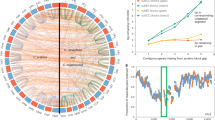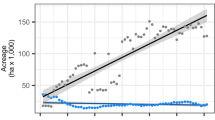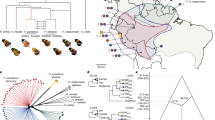Abstract
CHROMOSOME translocation heterozygotes (T/+) are usually semisterile, but translocation homozygotes (T/T) if viable are usually fully fertile. If such a viable translocation were produced in an insect pest, T/T insects could be reared in captivity and released into the wild, where matings with wild types (+/+) would produce T/+ progeny.
This is a preview of subscription content, access via your institution
Access options
Subscribe to this journal
Receive 51 print issues and online access
$199.00 per year
only $3.90 per issue
Buy this article
- Purchase on Springer Link
- Instant access to full article PDF
Prices may be subject to local taxes which are calculated during checkout
Similar content being viewed by others
References
Serebrovsky, A. S., Zool. Zh., 19, 618 (1940).
Curtis, C. F., Bull. Ent. Res. (in the press).
Curtis, C. F., and Hill, W. G., I.A.E.A./F.A.O. Symposium on the Use of Isotopes and Radiation in Entomology, Vienna, 1967 (in the press).
MacDonald, W. W., Ann. Trop. Med. Parasit., 56, 373 (1962).
Laven, H., Nature, 216, 383 (1967).
Dobzhansky, T., Z.f. Indukt. Abst. Verebl., 64, 269 (1933).
Hickey, W. A., and Craig, G. B., Canad. J. Genet. Cytol., 8, 260 (1966).
Author information
Authors and Affiliations
Rights and permissions
About this article
Cite this article
CURTIS, C. Possible Use of Translocations to fix Desirable Genes in Insect Pest Populations. Nature 218, 368–369 (1968). https://doi.org/10.1038/218368a0
Received:
Issue Date:
DOI: https://doi.org/10.1038/218368a0
This article is cited by
-
Sex or poison? Genetic pest management in the 21st century
BMC Biology (2023)
-
Gene drives gaining speed
Nature Reviews Genetics (2022)
-
A common gene drive language eases regulatory process and eco-evolutionary extensions
BMC Ecology and Evolution (2021)
-
Systematic identification of plausible pathways to potential harm via problem formulation for investigational releases of a population suppression gene drive to control the human malaria vector Anopheles gambiae in West Africa
Malaria Journal (2021)
-
Modeling confinement and reversibility of threshold-dependent gene drive systems in spatially-explicit Aedes aegypti populations
BMC Biology (2020)
Comments
By submitting a comment you agree to abide by our Terms and Community Guidelines. If you find something abusive or that does not comply with our terms or guidelines please flag it as inappropriate.



